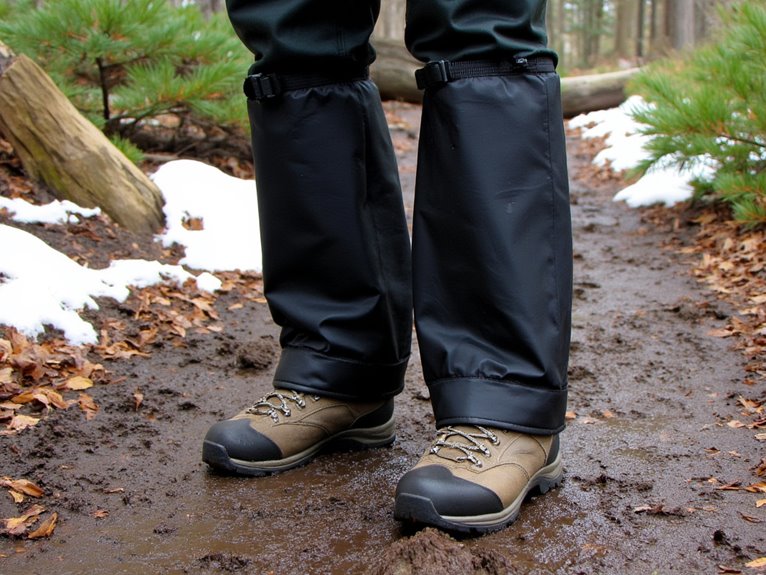How to Use Gaiters to Protect Against Snow, Mud, and Ticks
You’ll protect yourself by choosing knee-height gaiters with waterproof membranes like GORE-TEX for deep snow, or mid-calf versions for light rain and mud. Position them with front closures forward, secure instep straps beneath your boot soles, and attach metal lace hooks to prevent slipping. For tick protection, select permethrin-treated gaiters with tight-weave fabric that creates an impenetrable barrier on your lower legs. Proper maintenance and specialized techniques will maximize their effectiveness across various outdoor conditions.
We are supported by our audience. When you purchase through links on our site, we may earn an affiliate commission, at no extra cost for you. Learn more. Last update on 16th December 2025 / Images from Amazon Product Advertising API.
Notable Insights
- Choose knee-height gaiters with waterproof membranes like GORE-TEX and 1000D nylon for maximum protection against snow and mud.
- Secure gaiters properly by positioning front closures forward, fastening instep straps beneath boots, and attaching metal lace hooks.
- Select permethrin-treated gaiters with tight-weave fabric to create an impenetrable barrier against ticks on lower legs.
- Pair gaiters with waterproof hiking shoes to form a comprehensive protective system covering gaps between footwear and clothing.
- Maintain effectiveness by cleaning after each use, reapplying water repellent spray, and promptly repairing damaged zippers or straps.
Understanding Gaiter Design and Key Features
When selecting gaiters for outdoor activities, understanding their fundamental design elements determines whether they’ll effectively protect your legs from snow, mud, and ticks. Height options range from ankle-focused lower gaiters to full knee-height models measuring 15-18 inches tall.
Understanding gaiter design elements—from ankle-height to full knee coverage—ensures optimal protection against snow, mud, and ticks during outdoor adventures.
Full-height gaiters provide maximum protection against deep snow and tall brush, while mid-calf versions balance coverage with mobility.
Gaiter materials considerably impact performance and durability. Breathable membranes like GORE-TEX block moisture while allowing perspiration escape. Polyurethane-coated nylon offers lighter water resistance for moderate conditions. Heavy-duty 1000D nylon reinforces high-wear areas against abrasion.
Closure systems guarantee secure fit and easy operation. Standard hook-and-loop strips provide adjustable entry, while top closures feature elasticized drawcords or cam buckles. Advanced models feature top-down zipper designs that allow easy on/off access even when wearing boots.
Instep straps prevent upward movement, ranging from simple laces to reinforced synthetic materials. Some gaiters feature insect repellent treatments to deter mosquitoes and ticks in buggy environments.
Choosing the Right Gaiters for Different Weather Conditions
How do environmental factors determine which gaiter specifications will deliver ideal protection? Your environment dictates critical gaiter materials and design choices. Cold, wet conditions require waterproof membranes like GORE-TEX or Dermizax HDM for reliable moisture barrier performance. Durable nylon packcloth works for moderate rain but lacks complete waterproofing.
| Condition | Height Needed | Material Priority |
|---|---|---|
| Deep Snow | Knee-height | Waterproof membrane + 1000D nylon lower |
| Light Rain | Mid-height | Water-resistant coating |
| Tick Areas | Full-length | Tight-weave fabric |
Snow depth determines height requirements—knee-high gaiters excel in heavy snow while calf-height options suit moderate conditions. Dense vegetation demands abrasion-resistant fabrics and secure closures. For mixed conditions, choose designs combining breathable upper sections with waterproof lower portions to optimize ventilation while maintaining protection. Quality gaiters should feature moisture-resistant properties to prevent water penetration and maintain performance over extended use. Similar to holster selection, prioritize gaiters with adjustable cant angles or closure systems that allow customization for optimal fit and performance across varying terrain conditions.
Proper Fitting and Wearing Techniques
Three critical steps guarantee your gaiters deliver maximum protection: proper positioning, secure fastening, and movement verification.
Start with boots on, aligning front closures forward and placing straps on the outer leg side. Wrap fabric completely around your lower leg, covering ankle and boot upper evenly.
Position instep straps beneath boot soles for stability while avoiding walking interference. Attach metal lace hooks securely to prevent upward migration.
Close front fasteners completely from bottom to top, creating continuous seals without over-tightening. Focus on adjusting fit using top cinch cords around your calf for comfort without circulation restriction.
Securing closures requires firm pressure on hook-and-loop fasteners to eliminate penetration points. Walk briefly to test for rubbing or slipping. Re-tighten components if shifting occurs during activity.
Tick Prevention Strategies With Gaiters
Why do ticks pose such a persistent threat to outdoor enthusiasts, and how can gaiters transform your defense strategy? Understanding tick behavior reveals they climb upward from grass and leaf litter, targeting your lower legs first. Gaiters create an impenetrable barrier at this critical entry point.
Permethrin-treated gaiters offer superior protection for outdoor activities. The synthetic insecticide provides up to two weeks of continuous repellent action through microencapsulated fibers.
3D mesh designs slow tick movement by 4-8 times compared to untreated surfaces.
Choose tear-resistant nylon or polyester gaiters with elastic cuffs to eliminate gaps. Water-resistant fabrics discourage tick attachment while maintaining breathability. Quality waterproof materials like those found in premium outdoor gear ensure your gaiters maintain their protective barrier even in wet conditions.
Target high-risk environments like wooded areas, tall grass, and brush during peak tick season from spring through fall.
When selecting gaiters for tick protection, consider pairing them with waterproof hiking shoes that feature seam-sealed construction to create a comprehensive barrier system against both moisture and pest infiltration.
Maintenance and Care for Long-lasting Protection
Your gaiters won’t maintain their protective effectiveness without proper care and maintenance routines. Inspect them after each use for damaged zippers, worn stirrup straps, and compromised closures.
Essential cleaning techniques include brushing off debris before hand washing with warm water and a coarse sponge. Avoid machine washing unless explicitly manufacturer-approved, as this preserves velcro and fabric integrity.
Reapply durable water repellent spray periodically to maintain waterproofing. Store gaiters in cool, dry locations with zippers closed and velcro fastened to prevent deformation.
Effective repair tips include patching small tears promptly rather than sewing, and replacing worn stirrup straps immediately. Keep velcro strips debris-free by brushing with an old toothbrush.
Always guarantee complete drying before storage to prevent mildew formation.
Frequently Asked Questions
Are Gaiters Necessary for Short Day Hikes or Casual Nature Walks?
Gaiters aren’t necessary for short hikes or casual walks on dry, clear trails, but they’re beneficial if you’ll encounter wet conditions, dense vegetation, or tick-prone areas for added protection.
Are Expensive Gaiters Significantly Better Than Budget-Friendly Options for Casual Hikers?
For casual hiking, you won’t notice significant performance differences between expensive and budget gaiters. Budget options provide adequate protection against snow, mud, and ticks, though durability may suffer with frequent use.
On a final note
You’ve now mastered gaiter selection, fitting, and maintenance techniques that’ll keep you protected across diverse outdoor conditions. Proper gaiters create an effective barrier against snow infiltration, mud splatter, and tick attachment when you follow correct installation procedures. Remember to inspect your gaiters after each use and clean them according to manufacturer specifications. With quality gaiters and proper technique, you’ll maintain dry, clean legs while reducing tick-borne disease exposure during outdoor activities.

